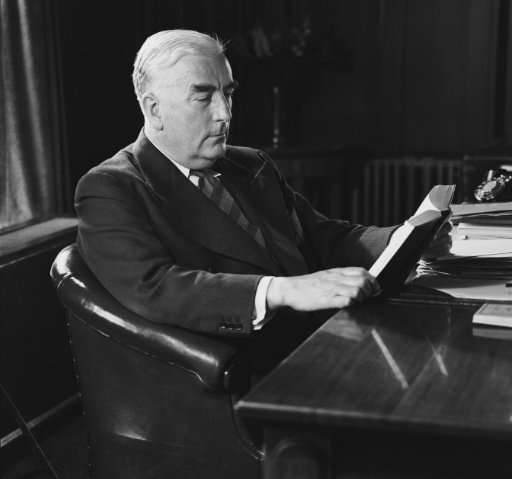On this day, 26 May 1935, Robert Menzies meets Winston Churchill for the first time at his ‘Chartwell’ home in Kent. Menzies was then taking just his first trip to Britain, but with the status that came with being Attorney General in the Lyons Government he was quickly introduced to some of Britain’s leading figures, particularly on the centre-right of politics.
Despite both men later proving to be titans of conservative politics in their respective countries, in the early years they often found themselves in disagreement. Unlike Churchill, Menzies in the 1930s was often a supporter of appeasement (though not as consistently or fervently as Lyons under whom he served), while later as Australia’s prime minister during the Second World War Menzies would often clash with Churchill in the British War Cabinet, which he complained was otherwise filled with ‘yes men’ who refused to adequately test Churchill’s decision making.
However, once the war had been won, Menzies was quick to appreciate that it was Churchill’s seemingly negative traits (self-confidence, stubbornness etc.) which had proven vital in winning the war. This was particularly the case during the Battle of Britain when the ‘mother country’ stood virtually alone against Nazi Germany and refused to succumb to it despite what then seemed to be overwhelming odds.
Menzies had always been impressed by the power of Churchill’s oratory, and after the war they became very close with Menzies often meeting up with Churchill during his frequent trips to Great Britain. When Churchill passed away in 1965 Menzies would serve as his pallbearer and give a heartfelt eulogy for BBC television, while he would also inherit Churchill’s ceremonial role as Lord Warden of the Cinque Ports.
This is how Menzies recalled their first encounter in his memoir Afternoon Light:
“My wife and I were week-ending in Surrey with Maurice Hankey, that courteous but effective Prince of Cabinet Secretaries. After lunch he suggested a walk across to Chartwell…
Mrs Churchill, as she then was, received us very pleasantly, but explained at once that ‘Winston’ was in the swimming pool, and that we should go out to see him. It was a splendid sight. The pool was large and of irregular shape and had, we were told, been built by Churchill himself. It was, as I later learned, heated. In the middle of the pool was a jutting form rather reminiscent of the Rock of Gibraltar. ‘Clemmie’, as I was later to know her, called out across the pool — ‘Winston, you have visitors.’ Nothing happened. She called again. The rock moved. It produced two hands, which plucked two lumps of cotton-wool from two ears as the rock stood up. The message was repeated, and the rock came ashore, glowering at us as severely as Gibraltar ever did at La Linea. I felt that though I had come, and had seen, I had not conquered.
Sir Ian Hamilton arrived for tea, and I found myself, involuntarily, to be a good listener. But I confessed to some disappointment. I made a note at about that time that there seemed to be a little more of ‘I told them so’ in Winston’s conversation than I would have expected. This impression I later found to be false, because I got to know better how almost single-handed had been his battle to alert the nation, and how bitterly frustrated he was at the euphoria which had overtaken his country, bemused by the ‘Peace Ballot’ and what we now know to have been a childlike belief that the League of Nations and its Covenant were an effective guarantee of peace, and that national rearmament was therefore not only unimportant, but would show a serious lack of faith! The general attitude was that Churchill was brilliant but erratic, an object of affectionate regret to the Conservatives, and a ‘warmonger’ to the pacifist wing of the Labour Party.
However, on that opening day at Chartwell, I thought I did rather better with Mrs Churchill. She showed me some brick walls (‘by Winston’) and a charming red brick cottage, built by Winston et alios. I can remember as if it were yesterday her whimsical remark that ‘this cottage is let for £100 a year, and is the only really economic job of brick-work Winston has done!’
I was interested to discover how he had gone about the production of his great life of his ancestor Marlborough (the first volume of which he had published two years before), and how he could achieve its vivid description of events, and in particular of the great battle victories of that amazing soldier. She took me into a large room where there was a huge relief map set out on an equally huge table. Winston, she told me, having, with the help of experts, assembled his historical material, would stand by the table, literally ‘view the landscape o’er’, Blenheim, Oudenarde, Ramillies, or Malplaquet, as the case might be, and dictate his story as if he were an eye-witness of the events, moving the troops about in his mind’s eye, noting the position of the sun and the features of the ground, and dictating his story with life and enthusiasm.
I was later to see much of his methods of work and of the way in which he prepared the first drafts of speeches and broadcasts. But that first glimpse, in 1935, explained a great deal to me. The years were to come when he would move many millions of people right round the world. He had, in his years of rejection — and dejection — learned the great truth that to move other people, the speaker, the leader, must first move himself; all must be vivid in his mind.”
Sign up to our newsletter
Sign up for our monthly newsletter to hear the latest news and receive information about upcoming events.


